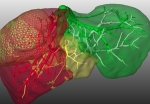Optimal Treatment of Tumours in the Liver by Optimisation with Partial Differential Equations
| Working Group: | WG Optimization and Optimal Control |
| Leadership: | Prof. Dr. Christof Büskens ((0421) 218-63861, E-Mail: bueskens@math.uni-bremen.de ) |
| Processor: | Dr. Hanne Tiesler |
| Funding: | CeVis (Bremen) |
| Project partner: | Centrum für komplexe Systeme und Visualisierung (CeVis), Bremen |
| Time period: | 01.08.2006 - 31.07.2009 |
 With various illnesses which cause tumours (liver, lung, bone tumours, carcinoma of the kidney) surgery is often no longer a viable option, whether on account of the size of the tumour or the physical shape of the patient. In such situations, local and minimally invasive techniques have proven to be a successful treatment alternative. The so-called thermo-ablation treatment destroys the malignant tissue by local heating or cooling. Examples of the treatment using local heating include radio-frequency (RF) ablation and thermotherapy induced by either laser or concentrated ultrasound.
With various illnesses which cause tumours (liver, lung, bone tumours, carcinoma of the kidney) surgery is often no longer a viable option, whether on account of the size of the tumour or the physical shape of the patient. In such situations, local and minimally invasive techniques have proven to be a successful treatment alternative. The so-called thermo-ablation treatment destroys the malignant tissue by local heating or cooling. Examples of the treatment using local heating include radio-frequency (RF) ablation and thermotherapy induced by either laser or concentrated ultrasound.
The priority of the project is RF ablation with bipolar systems. This involves placing an internally cooled probe with two electrodes in the vicinity of the malignant tissue. The electrodes are connected to a generator of 30W to 200W at a frequency of 500kHz. As soon as the generator is switched on the tissue in the vicinity of the probe is heated by the electrical current to above 60°C. This denaturises the proteins of the heated tissue and the cell dies. When all tumour cells have been destroyed by the denaturation of their proteins, the treatment has been a success.
In tissue which is not in the immediate vicinity of the probe, the critical temperature can only be achieved by propagation of the heat. In the surrounding tissue, the blood supply from large vessels and capillaries produces a significant effect which has to be modelled very accurately. To reduce the area of the coagulating tissue (i.e. denaturised proteins) and to reduce the influence of the blood supply the tumour can be treated with several probes at the same time.
If RF ablation treatment is to be reliable, it is essential that there is careful planning and monitoring during the operation. In the patient's own interest it must be ascertained in advance that the tumour can be completely destroyed by the treatment and that the result achieved can be monitored during and after the operation.
The mathematical problem is described by a four-dimensional non-linear partial differential equation. The parameters of the various types of tissue have to be identified before the optimisation (and optimal control) can be introduced.
Publications
- H. Tiesler, I. Altrogge, T. Kröger, C. Büskens, H. Peitgen, T. Preusser.
Modeling, Simulation and Optimization of Radio Frequency Ablation.
ISNM-Serie, Birkhäuser, 2010.

